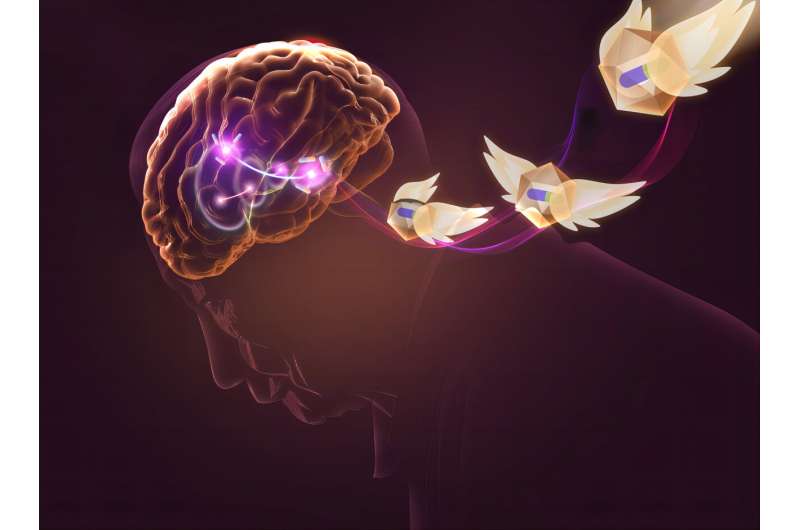This article has been reviewed according to Science X's editorial process and policies. Editors have highlighted the following attributes while ensuring the content's credibility:
fact-checked
peer-reviewed publication
trusted source
proofread
Circuit-specific gene therapy brings new hope for treatment of Parkinson's disease

Researchers from the Shenzhen Institute of Advanced Technology (SIAT) of the Chinese Academy of Sciences (CAS) and their collaborators have developed a gene therapy strategy to selectively manipulate Parkinson's disease-affected circuitry and attenuate the core motor symptoms of Parkinson's disease in rodent and nonhuman primate animals.
The study was published in Cell on Nov. 2.
Parkinson's disease, characterized by the loss of midbrain dopaminergic neurons, is one of the most common neurodegenerative diseases in the elderly population, affecting more than 6 million people worldwide.
Dopamine receptor D1-expressing and D2-expressing medium spiny neurons (D1-MSN and D2-MSN, respectively) constitute 90% of neurons in the striatum. Both D1-MSN and D2-MSN receive dopaminergic innervation from the substantia nigra pars compacta (SNc), yet play opposing roles in movement control.
D1-MSNs that project to the globus pallidus internal segment (GPi) and substantia nigra pars reticulata (SNr) constitute the direct pathway and promote movement. In contrast, D2-MSNs that project to the globus pallidus external segment (GPe) form the indirect pathway and mediate movement inhibition.
In Parkinson's disease, dopamine depletion causes hypoactivity of the direct pathway and hyperactivity of the indirect pathway, resulting in various motor symptoms.
Levodopa (L-Dopa)-based treatment, which helps to restore the dopamine system's function, is the mainstay therapy for Parkinson's disease. Unfortunately, almost all patients given long-term L-Dopa treatment suffer from motor complications (e.g., motor fluctuations and dyskinesia). Thus, precise, efficient and stable treatments are greatly needed.
Since the SNr receives dense projection from the D1-MSNs and no projection from the D2-MSNs, the researchers proposed that D1-MSNs could be selectively labeled by injecting highly efficient retrograde adeno-associated virus (AAV) into the SNr and then be exclusively manipulated by introducing neuronal activity-regulating elements in the retrograde AAV.
To achieve the above objectives, they developed a novel AAV capsid, AAV8R12, for efficient retrograde labeling of the D1-MSN in the striatum as well a new promoter G88P2/3/7 with strong D1-MSN activity. With a chemogenetic effector rM3Ds to match systemic administration of the activation drug, this gene therapy strategy was able to specifically activate D1-MSN and thus drive the D1-MSN-mediated direct pathway.
Typical motor symptoms such as bradykinesia, rigidity, and tremor were greatly improved in primate models with Parkinson's disease after applying the circuit-specific approach targeting D1-MSNs. For example, bradykinesia was greatly reduced, tremor was completely eliminated, and motor skills were restored.
Unlike L-Dopa treatment which non-specifically activates the dopamine system in both the brain and peripheral organs, this new approach precisely manipulates the D1-MSN-mediated direct pathway.
In addition to its therapeutic effectiveness, this circuit-manipulating gene therapy has faster onset and longer duration compared to L-Dopa treatment. The alleviation of symptoms after a single drug administration lasts longer than 24 hours compared to a typical six-hour therapeutic window for L-Dopa. Motor complications such as dyskinesia shown after L-Dopa treatment were absent after applying the gene therapy over an extended period (i.e., over eight months).
Besides showing potential for treating Parkinson's disease, this circuit-manipulating gene therapy paves the way for future development of targeted, circuit-based therapeutic strategies for other brain disorders.
More information: Circuit-specific gene therapy reverses core symptoms in a primate Parkinson's disease model, Cell (2023). DOI: 10.1016/j.cell.2023.10.004. www.cell.com/cell/fulltext/S0092-8674(23)01086-3

















